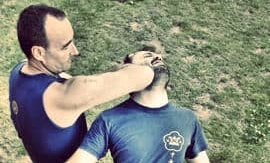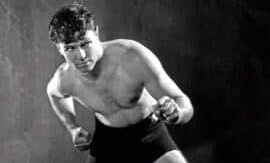
THIS DISCUSSION IS NOT INTENDED TO FUEL A DEBATE ON WHICH MARTIAL ART IS THE MOST SUPERIOR. RATHER, THE INTENTION HERE IS TO SUGGEST THAT ACTIVELY ENGAGING IN A COMPARISON OF SKILLS DEVELOPS A MARTIAL ART IN A POSITIVE MANNER.
In this view, contemporary Beimo may facilitate a further improvement of the central theories in Wing Chun. In this sense, Beimo is a scientific process of development. However, training for Beimo does not necessarily require that you change your Wing Chun style. It may simply mean that you change your approach to training your style of Wing Chun.
There is often debate within the Wing Chun community whether sparring should be an active component of training and improving Wing Chun skills. There is a dichotomy in opinion. Some argue that Chi Sau is the pinnacle of Wing Chun training and little else is required. In this view, the art is considered too dangerous to practice in sparring or that this very notion waters down the intended purpose of the art as a true fighting system. In contrast, those that do believe in the benefits of sparring are thought to take sparring to the extreme of a pseudo Boxing match—in which the precise theories of Wing Chun are lost in a fierce medley of Boxing or Mixed Martial Arts gloves.
While there is a valid argument for both camps, what is required is a compromise between these two viewpoints wherein there is a scientific methodology in which to test and develop generic martial art skills. The objective here is to address how to prepare scientifically for style vs. style comparisons—San Shou or MMA competition. This will require that we firstly address what skills and attributes we should be developing, and secondly how we should be developing such attributes.
The answer lies in the strategy of Wing Chun fighting. What distinguishes Wing Chun from most martial art styles is the attention to detail it promotes. The focus on correct structural integrity, efficiency of movement, and the development of short distance power. These are the concepts that we should be seeking to improve by scientifically testing against a resisting opponent with no knowledge of Wing Chun. If these concepts are valid, then they would hold up to any test regardless of the method of testing. That is, whether tested in a style vs. style comparison.
Regardless of this, some argue that Wing Chun is too dangerous to be tested in a competitive environment; citing that real fighting is not governed by rules and therefore striking the eyes, groin or knees would be effective enough. This perspective is unscientific and fanatical, as it follows a blind faith. Note that other styles of martial arts are also capable of using the same “deadly tactics”, which makes this argument void. You must define Wing Chun on its founding concepts. To investigate it is necessary to keep certain variables constant in order to test the theories of Wing Chun. In this sense, removing the option of attacking the groin or eyes means that both fighters can compare skills on a comparative basis, in order to see which aspect of their style really works.
Rules are essential because they provide some control of the variables in a contest. There are many possibilities of what could happen in a real fight. Hence, rules control certain variables and force students to focus on the core universal martial arts skills of timing, distance control, and mobility. These skills are key to facilitating the theories of Wing Chun, but how do you develop these attributes in a scientific manner for Beimo?
In simple terms, aspects of Chi Sau training can be useful in mitigating the clinch range of most MMA or Muay Thai fighters. The elaborate games of trapping will not help, but the intuition of knowing where your arms are in relation to the opponent’s arms is valuable because it facilities the ability to control arms and move through tight spaces.
However, there are limitations to Chi Sau. The most obvious being that you start in a connected position that is close to the opponent. Any contest would require that you approach from a distance to engage the opponent; therefore, control of distance is paramount. This does suggest that Gwor Sau should be a better alternative for fight preparation. While it is an effective training methodology for bridging skills, it still lacks many answers to the question of how to bridge an experienced fighter moving out of range.
Key to this point is how do we develop the universal attributes of timing, distance control, and mobility in order to bridge a mobile opponent. One alternative is to incorporate the skills of Chi Sau and Gwor Sau into a new form of free fighting (San Da). Another is to develop bridging skills with no contact at all, and this suggests training with either Boxing or MMA gloves.
While Boxing may not be helpful in the development of your Wing Chun skills, there is value to wearing Boxing or MMA gloves. Real punches thrown with gloves induce a different physical and emotional reaction than Chi Sau or Gwor Sau. Physically, it is more tiring and emotionally draining. On a technical level, using Boxing or MMA gloves can be a hindrance to the natural seizing and clinching skills of Wing Chun. In fact, it may also provide a false sense of security. Yet, the problem lies in the physical hindrance of wearing gloves, their size, and that makes it difficult to work on short distance power and efficiency of movement. There is also the risk of Wing Chun practitioners becoming bad boxers by emulating their practices. However, there are also benefits to be gained in developing timing, distance control, and mobility.
Overall, there is no right or wrong approach to training. What counts is your ability to critically consider how you are training with the aim of improving it. One factor most often overlooked is the importance of fitness and conditioning.
Yes, it does. Fitness and conditioning are essential for all forms of fighting, whether self-defence or competitive. Regardless of your skill set, if you are unable to cope with the physical requirements of using your body under an extreme amount of combat stress, then you are unlikely to be able to compare your skills.
Exhaustion and fatigue are the biggest problems encountered in any fight. If you are exhausted, then you are unlikely to be able to perform simple repetitive tasks or even think clearly under pressure. In fact, combined with fatigue, it is difficult to keep your arms up in defence.
Combat stress induces exhaustion and fatigue very quickly, and these aspects will have a detrimental effect on your performance. Consider that many fighters from combat sports such as Muay Thai, Kickboxing, Brazilian Jiu-Jitsu and MMA spend an equal amount of time, if not more, on improving their fitness and conditioning.
The training culture of combat sports incorporates a strong focus on fitness and conditioning because it is well accepted that when all skills are equal, what may be the defining factor is the degree of fitness amongst the fighters. Therefore, no fighter wishes to take this aspect to chance.
Fitness is key to Beimo because if you wish to compare skills, first you must have a good level of fitness and conditioning to survive the duration of a comparative contest. It is not wise to take the view that a fight will be over in a second or in a single or flurry of punches. Even for those that train for self-defence and good health, fitness and conditioning are important—especially if you train Wing Chun as a hobby.
In closing, ultimately it is not the science of the art, but how we train the art that is the defining factor. Training scientifically means having a methodology that can be controlled and replicated. However, the aspect of fitness and conditioning is key to a complete scientific approach to fighting. In future articles, I will be discussing the psychological importance of fitness training for Beimo.



















